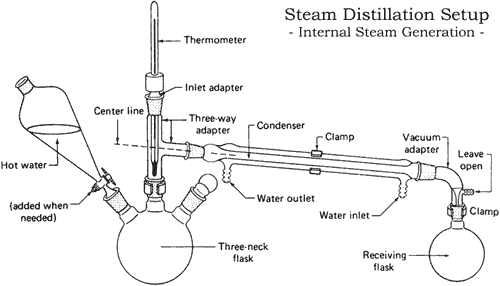(Chief Bee)
06-05-04 10:56
No 511598
(Rated as: good read)
I have finally added the second half of Zubrick's excellent illustrated distillation technique tutorial.
In addition to the sections on Simple & Vacuum Distillation, you can now learn about the basics of Fractional & Steam Distillation as well.
The Organic Chem Lab Survival Manual
James W. Zubrick
Chapter 20 - Distillation For Dummies (../rhodium /equipm

The Hive - Clandestine Chemists Without Borders
(Newbee)
06-17-04 21:54
No 514000
Reflux and Balance.
It would be impractical to have an enormously long tower to achieve the separation we require. Fortunately, there is a little trick that may be used to keep the tower to manageable proportions, yet provide excellent separation. Left to its own devices, the tower works by condensing out richer and richer mixtures the higher you go, the condensate running down again until it re-vaporizes and improves the separation. You can hurry this along by making the column shorter and putting a condenser on top. All the vapour that reaches the top if the column is condensed and the enriched liquid is returned to the column. In washing down the packing this liquid, which evaporates and rises again, causes the top of the column to become very enriched with the lightest fraction. The column compensates for this rude interference by compressing the separation between fractions lower down in the column, but this doesn't matter so long as we confine ourselves to extracting from the top.
Tried and true practice shows that you can achieve almost perfect separation between fractions by using a tower of about 3.5 cm diameter and around 1 metre long. The secret is to allow time for the process of wash-down and separation to settle to a stable condition by imposing 100% reflux for about 4 hours. After this time, at least the top half of the tower will be filled with almost pure methanol (at the start), as indicated by the temperatures up the tower having settled down to a stable condition - ie the tower is balanced. By bleeding off methanol slowly, maintaining a reflux ratio of at least 10 to 1 (return 9 parts for every 1 drawn off, the ratio being that drawn off versus that supplied by the column) you can maintain this balance and remove all the methanol with only a small 'blur' when ethanol begins to follow the exhausted methanol up the column. The point at which pure ethanol starts being drawn off is obvious from both the increased temperature at the head of the column and the clean smell of the product. This will be 95% ethanol - remember it forms an azeotropic mixture with water and you can't get better than that. Finally, after about 20 to 24 hours (the price you pay for purity), the pungent tails with all the nasty congeners will start to make themselves known.
Conclusion.
So there we are. I hope this article has been useful and not bruised too many firmly held opinions. For those who hold the latter, all I can say is go and check it out for yourselves. As I have stated before, I believe there is a place for all types of still, from the simplest alembic to the full reflux fractionating column. My personal preference is for the latter as I find, despite first appearances, it is cheaper and less time consuming in the long run. I also have this funny notion that I should know exactly what's in a drink that I guzzle, and by adding known ingredients to a pure product I feel more in control of my destiny. Incidentally, it's not only booze that I use this product for - as a keen cook I enjoy the opportunity to make my own food essences.
http://homedistiller.org/howitworks.pdf